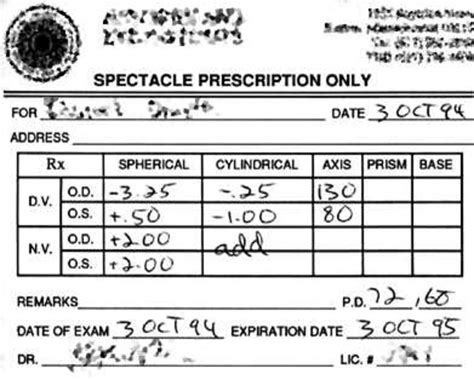How to Read Your Spectacle Prescription: A Comprehensive Guide
Understanding your eyeglass prescription can feel like deciphering a secret code. But don't worry, it's simpler than you think! This guide breaks down the key components, empowering you to confidently order glasses online or discuss your vision needs with your eye care professional.
Decoding the Numbers and Abbreviations
Your prescription is a detailed summary of your vision needs. It uses specific abbreviations and numbers to describe the lenses required to correct your vision. Let's break down the common elements:
1. Sphere (SPH):
- What it is: This indicates the correction needed for nearsightedness (myopia) or farsightedness (hyperopia).
- Positive numbers (+): Indicate farsightedness (hyperopia). You have trouble focusing on nearby objects.
- Negative numbers (-): Indicate nearsightedness (myopia). You have trouble focusing on distant objects.
- 0.00: Means no correction is needed for nearsightedness or farsightedness.
Example: SPH +2.00 means you're farsighted, and +2.00 diopters of correction are needed. SPH -1.50 means you're nearsighted, and -1.50 diopters of correction are needed.
2. Cylinder (CYL):
- What it is: This corrects for astigmatism, a condition where the cornea (the front surface of your eye) is irregularly shaped. This causes blurry vision at all distances.
- Number value: Represents the degree of astigmatism. A higher number indicates a greater degree of astigmatism.
- 0.00: Means no astigmatism correction is needed.
Example: CYL -1.00 indicates astigmatism requiring -1.00 diopters of correction.
3. Axis (AXIS):
- What it is: This number is paired with the Cylinder (CYL) value. It specifies the orientation of the astigmatism in your eye. It's measured in degrees (from 0 to 180). It indicates the direction of the irregular curvature of your cornea.
- Number value: Ranges from 0 to 180 degrees. It's crucial for accurate lens production.
Example: AXIS 10 indicates that the astigmatism is oriented at a 10-degree angle.
4. Add:
- What it is: This value is primarily found in prescriptions for reading glasses or bifocals/progressives.
- Purpose: It specifies the additional power needed for near vision.
- Positive numbers (+): Represent the added power for close-up vision.
Example: Add +2.00 means an additional +2.00 diopters are added to the distance prescription for near vision tasks.
5. Prism:
- What it is: This corrects for double vision or eye misalignment. It's less common.
- Value: Indicates the amount of prism correction needed.
- Base: Specifies the direction of the prism. (e.g., Base-Out, Base-In, Base-Up, Base-Down)
6. PD (Pupillary Distance):
- What it is: This is a crucial measurement representing the distance between the centers of your pupils in millimeters. This measurement is essential for proper lens alignment. Incorrect PD can lead to eye strain and discomfort.
- Measurement: Usually given as two numbers (e.g., 62/62) representing the distance for each eye individually, or a single number representing the total distance.
Understanding Your Prescription's Format
Your prescription may be formatted slightly differently depending on the eye doctor, but the fundamental components remain the same. You might see information organized by eye (OD - right eye, OS - left eye, OU - both eyes).
Example:
OD (Right Eye):
- SPH: -1.00
- CYL: -0.50
- AXIS: 170
OS (Left Eye):
- SPH: -0.75
- CYL: 0.00
- AXIS: 000
- ADD: +2.00 (if applicable)
PD: 64
Important Considerations
- Always consult your eye care professional: This guide is for informational purposes only and shouldn't replace professional advice.
- Accuracy is key: Ensure you use the correct prescription numbers when ordering glasses online. Incorrect information can lead to blurry vision and eye strain.
- Regular eye exams: Schedule regular eye exams to monitor your vision health.
By understanding these key elements, you can navigate your eyeglass prescription with confidence. Remember, accurate information is crucial for comfortable and clear vision.
